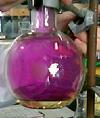| Sodium - a common danger in pet foods |
| Some pet foods have 4 - 15 times the amount of recommended sodium |
| What is sodium? What is salt? |
We hear a lot about salt intake and "how much
sodium" is in your diet. Is salt and sodium the same? Sort of. Salt also
goes by the name of sodium chloride because it is made up of two minerals or
ions (electrically charged atoms) sodium and chloride. Both are macrominerals
in nutrition (see six basic nutrients). One ingested, these ions split up and
will have independent levels in the blood stream. When evaluating
"salt" levels in the blood stream, the ion sodium is primarily looked
at. As a result we talk about "sodium" levels and often use these
terms interchangeably.
Is all salt, sodium chloride?
Nope. In chemistry, salts comprise a huge variety of compounds. (Geek
definition: a salt is the ionic product of a reaction of an acid and a base
chemical) In short, there are many similar compounds.
|
| What is iodized salt exactly? Do pet foods use iodized salt? |
 |
| Iodine in a gaseous state |
|
Iodine an another mineral that is necessary for the body.
Unlike sodium and chloride however, mammalian bodies need far less iodine and
for this reason iodine is classified as a micromineral versus a macromineral
like sodium and chloride. Iodine's primary use in the body is as a cofactor for
the thyroid hormones T3 (triiodothyronine) and T4 (thyroxine or
tetraiodothyronine). It is also required for proper brain development in
fetuses, neonates and the growth stage of life.
While we often think of all salt as having iodine, this is not how salt
naturally comes. Most salt sources do not have iodine at natural levels that
would supply what a mammal needs. Iodized salt is the very first Functional
Food. In the pet world, the first therapeutic diet or function food is Hill's
Pet Nutrition's k/d which was developed in 1948 by Dr Mark Morris. Salt is
converted to iodized salt
typically by spraying potassium iodate1
onto it.
Do most pet foods use iodized salt?
Typically this is not the case as other ingredients necessary to make up pet
food naturally contain iodine. Fish, sea vegetables, and shellfish are high in
iodine as are organ meats such as liver. Egg, dairy and meats also contain
moderate levels of iodine. Even grains can have iodine in it. As a result, the
additional expense of iodized salt may not be necessary as virtually all pet
foods have more than the dietary requirement of iodine in it.
1.
While
it sounds like a salt, potassium iodate is indeed an ionic compound but not
technically a salt. It is iodate: meaning that the potassium atom is attached
to iodate: IO3-. Which is an iodine atom and three oxygen
atoms. There are a couple iodine salts however that may be part of iodized salt
such as potassium iodide (KI) and sodium iodide (NaI). The last inorganic
iodine source is sodium iodate (NaIO3).
|
| There is NO legal maximum of salt in pet foods! |
AAFCO (American Association of Feed Control Officials) is
the main governing body overseeing pet foods. They establish the maximums and
minimums of nutrients for dogs and cats. Currently there are 38 canine minimum
nutrients and 46 feline minimum nutrients required to make any given pet food.
However only 11 of these canine nutrients have maximums and only 4 of the
feline nutrients have maximums. Fifty years ago, the presence of deficiency was
a common problem. Today the dangerous presence of excess is more common. In
many cases the excess of nutrients can cause as much damage as the deficiency
of that same nutrient.
Currently there is no upper limit to salt in dog or cat foods. This means that
despite the fact that we know that excess sodium can worsen such common
conditions as hypertension, kidney disease and heart disease, companies can put
as much salt in the food as they would like. Furthermore there is no
requirement to place the sodium amounts on the pet food label. In most cases,
you have to contact the company. As salt is a strong taste enhancer for dogs
and cats as it is to people, many pet food companies place large amounts of
salt into their foods to enhance palatability, do not give the consumer any
idea of how much salt is in the food other than the ingredient panel (from
which you cannot tell salt levels), and may or may not give any care to the
potential damage and harm that that salt is causing the pet. This is scary! It
is important that when we choose a pet food, we
|
| How much salt is too much for my pet? |
|